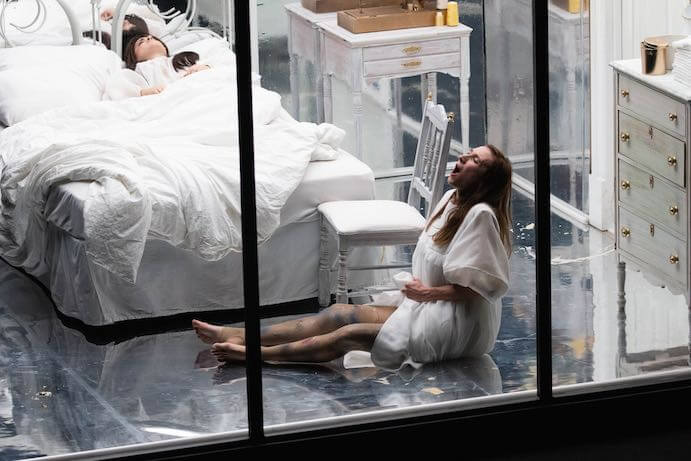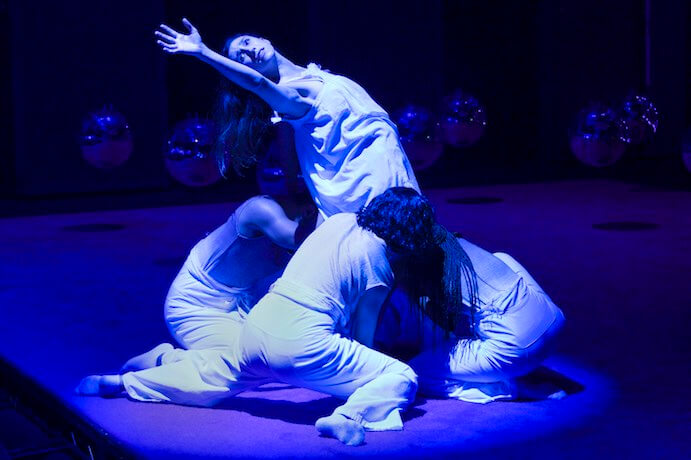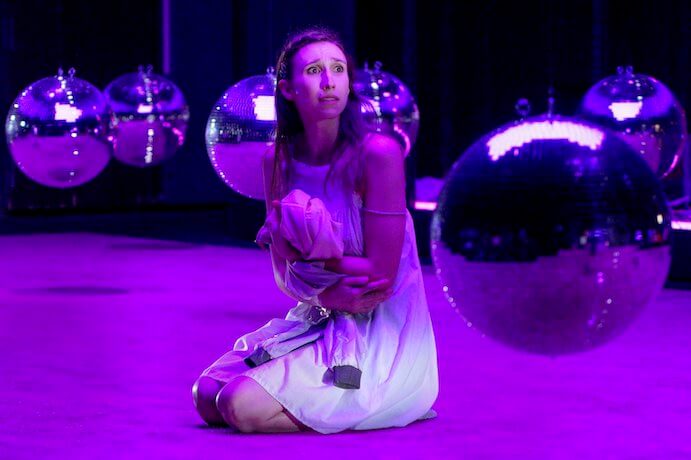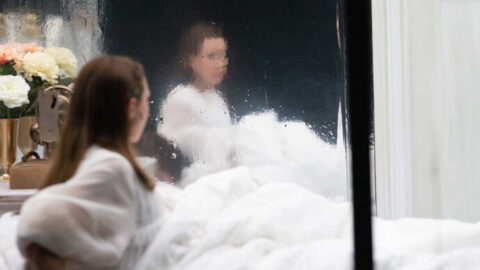Content warning: sexual assault
In the opening act of Claude Debussy’s 1902 opera Pelleas et Melisande, the audience is dropped into a mysterious forest with no explanation of time or place. A woman peers into a fountain. She is cold. Why? Who is she and where is she from? Playwright Maurice Maeterlinck’s sparse French symbolist libretto does little to explain these circumstances. Instead, Debussy’s music provides the clues we need to settle into the story: ambiguity is the point, and this might be a dream.
In p r i s m, a riveting new opera from composer Ellen Reid and librettist Roxie Perkins, audiences are given a similarly disorienting Act One experience. This concise, 80-minute dramatic punch of an opera received its world premiere in Los Angeles November 29 through December 2 at the Roy and Edna Disney/CalArts Theater (REDCAT) via LA Opera and Beth Morrison Projects (the work’s commissioner). Next month its “rolling premiere” continues in New York, where it will be presented with the same cast as part of BMP and HERE Arts Center’s PROTOTYPE Festival in collaboration with La MaMA and Trinity Church Wall Street.
As p r i s m begins, audiences are drawn immediately into a bright white cube, a Sanctuary “(as it should be).” In this space a mother and daughter named Lumee and Bibi recite strange incantations and perform well-rehearsed rituals and games. Draped in flouncing gossamer white gowns, they react emotionally, physically, and psychologically to their unexplained confinement.

Reid and director James Darrah draw their audience into this unusual world instantly, skillfully. Instead of questioning why, where, or when, we accept the premise and are swept up by the music and the characters’ emotions. What is that intense blue light seeping under the door that so frightens Lumee and Bibi? Perkins offers no immediate explanation; the characters’ visceral, terrified reactions give us all the information we need.
Inside this odd cube of bright white light, Bibi is in pain. Her legs are bruised and limp, incapable of bearing her slight weight. Her face is expressive. Her voice is powerful, precise, with round, elegant edges. Soprano Anna Schubert is revelatory in this role.
Suddenly, it is intermission. It must have been at least 40 minutes, but it felt like 20. There is so much to absorb in Reid’s eclectic score–the timbre, texture, melody and harmony of which transport listeners to an alternative reality. Perkins’ libretto is challenging: sparse and angular, ambiguous and abstract. But sometimes a challenge is a gift. Here, it provides Reid with ample space for inventive musical storytelling.
Reid’s score for Act One is cinematic, impressionistic, romantic. Woodwinds meander like Debussy’s Faun before melting into more contemporary, dissonant territory. This is a familiar soundscape–call it modern opera-land–and with Schubert as Bibi and the strong mezzo-soprano Rebecca Jo Loeb as Lumee giving voice to the story, it is a musically satisfying place to exist.

The score for p r i s m lists three characters: Lumee, Bibi, and something called “Chroma,” a psychological and dramatic force sung here by 12 members of the Choir of Trinity Wall Street. In this production, “Chroma” acts less like a third character and more like a startlingly beautiful addition to the small orchestral ensemble. Embedded among the strings and woodwinds, they performed exceptionally on opening night, conducted with enthusiasm and skill by Julian Wachner.
Reid is an adept choral composer, and in p r i s m she wields that strength to maximum effect. “Chroma” receives some of the composer’s most inventive writing–music with inherently dramatic impulses. “Chroma” is at once a character’s psyche and a sort of Greek Chorus. Chroma is pain and joy. Chroma is memory and dementia.
This opera should be experienced without spoilers. It should unfold, as it is so carefully crafted to do, through Perkins’ smart, abstract libretto. It should pour over audiences in crashes of unexpected musical moments. And it should reveal itself in waves of understanding, like the discovery of a repressed memory. But even if you know what is coming, you won’t be prepared for the sheer force of the music and acting that propel this story forward in Acts Two and Three.
In the lobby during intermission at REDCAT, Bibi appeared. Having just been sucked out into “the blue” by a pack of grabbing, pawing dancers, she was vaulted above the crowd, carried by those same dancers back into the theater. The audience followed.

Now, in place of Lumee and Bibi’s Sanctuary cube are disco balls and bass drops. Reid’s music shifts wildly; lush strings and harp are replaced by amplified and distorted percussive elements that mimic aggressive club music. As the intensity of the story ramps up, so does the frenetic virtuosity of Reid’s writing. To communicate extreme physical and psychological experiences, she pushes voices and instruments to their most extreme ranges.
Things come into focus slowly, barely. Lumee and Bibi’s “Sanctuary” mantras begin to make sense. The blue light appears. We understand in flashes that Lumee left Bibi alone, underage and vulnerable in the club. While her mother partied, Bibi was assaulted and raped.
“Oh no, I liked that scrunchie,” Bibi whimpers, lying along in the middle of the floor.
So often on the opera stage traumatic assaults happen to women. Here, an assault–or the relived memory of one–is experienced by the lead character. Intimate, seemingly trivial details like the loss of that scrunchie or the blue glow of the club’s lights draw the audience viscerally into Bibi’s experience. For survivors of assault, small details like these often seer themselves irreversibly into the memory, embedded forever into the material of the brain.

Both Reid and Perkins drew from lived experiences to create this story. Because of that, this surreal story is strikingly realistic in its portrayal of trauma and repressed memories. The result: fully developed, compelling female characters that audiences can connect and empathize with on a deeply personal, intense level.
Act Three begins abruptly, drawing us back into Sanctuary “(as it is).” Now, we see Lumee and Bibi’s environment unfiltered. Rags. Trash. It is a dirty, sad existence. The “safe” space in which Lumee imprisoned Bibi is not a happy one.
We learn that Lumee is desperate to forget, to make Bibi forget, to erase the past. But Bibi understands that freedom comes not through suppression, but through remembering. She decides to run, run, run towards truth and freedom. Above all, p r i s m is about the power that comes from choosing to survive.
Through endlessly creative, eclectic music, Reid takes us into a fuzzy place where repressed memories and reality blur. It is not always an easy space in which to sit, but it is one that sticks, lingering in ears and minds for days like mist. It serves as a reminder that when women tell their own stories, when the complexity of a victim’s internal experience is fully fleshed out, the result can be powerful.
























